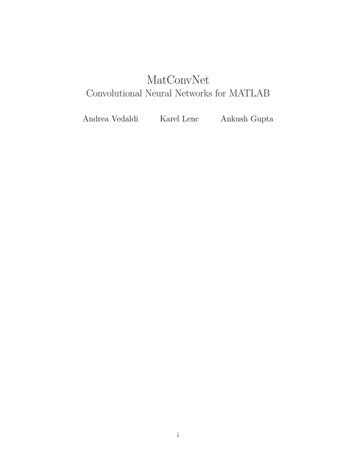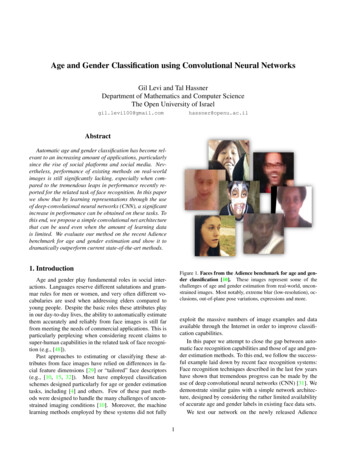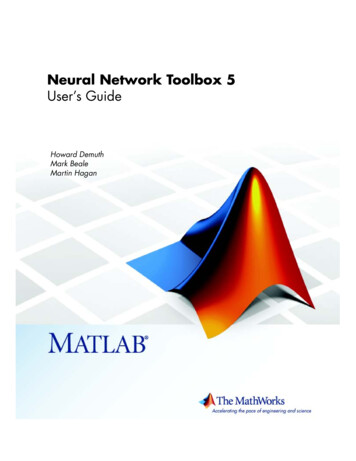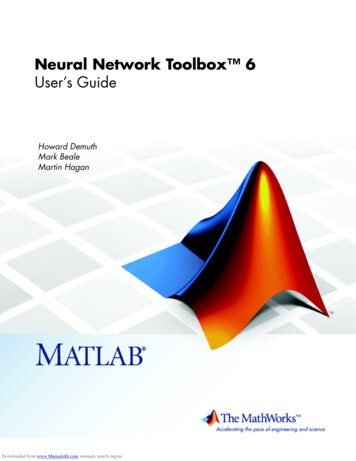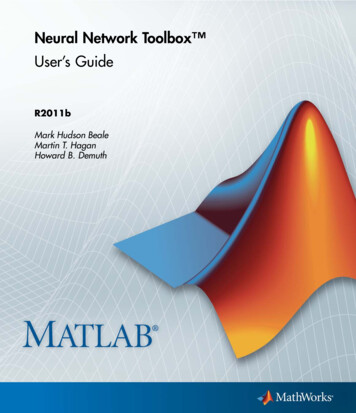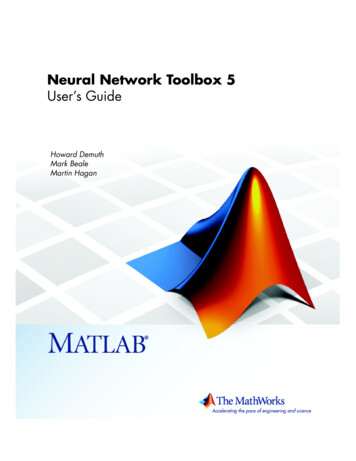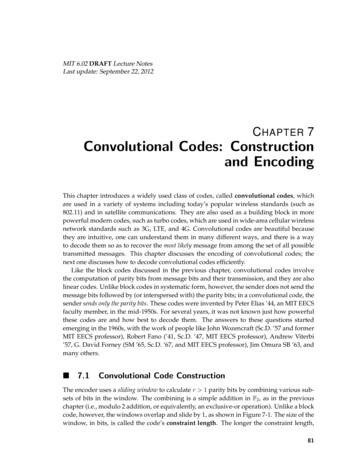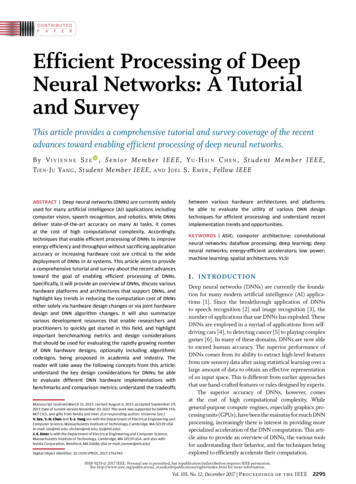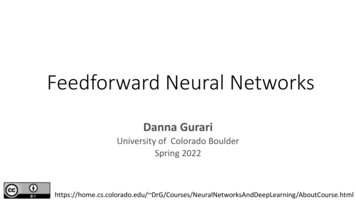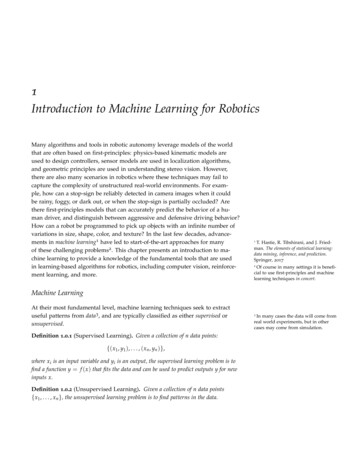
Transcription
Convolutional Neural Networks forVisual RecognitionLecture 1 - OverviewFei-Fei Li, Ranjay Krishna, Danfei XuLecture 1 - 1March 30, 2021
Today’s agenda A brief history of computer vision CS231n overviewFei-Fei Li, Ranjay Krishna, Danfei XuLecture 1 - 2March 30, 2021
Today’s agenda A brief history of computer vision CS231n overviewFei-Fei Li, Ranjay Krishna, Danfei XuLecture 1 - 3March 30, 2021
Convolutional Neural Networksfor Visual RecognitionA fundamental and general problem in Computer Vision, that has roots inCognitive ScienceBiederman, Irving. "Recognition-by-components: a theory of human image understanding." Psychological review 94.2 (1987): 115.Fei-Fei Li, Ranjay Krishna, Danfei XuLecture 1 - 4March 30, 2021
Image Classification: A core task in Computer VisioncatThis image by Nikita islicensed under CC-BY 2.0Fei-Fei Li, Ranjay Krishna, Danfei XuLecture 1 - 5March 30, 2021
Image by US Army is licensed under CC BY 2.0Image is CC0 1.0 public domainImage by Kippelboy is licensed under CC BY-SA 3.0Image by Christina C. is licensed under CC BY-SA 4.0Fei-Fei Li, Ranjay Krishna, Danfei XuLecture 1 - 6March 30, 2021
There are many visual recognition problems thatare related to image classification, such asobject detection, image captioning, semanticsegmentation, visual question answering, visualinstruction navigation, scene graph generationFei-Fei Li, Ranjay Krishna, Danfei XuLecture 1 - 7March 30, 2021
Object detectioncarAction recognitionbicyclingemTiThis image is licensed under CC BY-NC-SA 2.0;changes madeThis image is licensed under CC BY-SA 3.0;changes madeFei-Fei Li, Ranjay Krishna, Danfei XuScene graph prediction person - holding - hammer Captioning:a person holding a hammerThis image is licensed under CC BY-SA 3.0;changes madeLecture 1 - 8March 30, 2021
Convolutional Neural Networksfor Visual RecognitionHierarchical computing systems with many “layers”, that are very looselyinspired by NeuroscienceFei-Fei Li, Ranjay Krishna, Danfei XuLecture 1 - 9March 30, 2021
Last time: Neural NetworksxW13072Fei-Fei Li, Ranjay Krishna, Danfei Xuh100W2scat10Lecture 1 - 10March 30, 2021
Convolutional Neural Networksfor Visual RecognitionA class of Neural Networks that have become animportant tool for visual recognitionFei-Fei Li, Ranjay Krishna, Danfei XuLecture 1 - 11March 30, 2021
Core ideas go back many decades!The Mark I Perceptron machine was the firstimplementation of the perceptron algorithm.The machine was connected to a camera that used20 20 cadmium sulfide photocells to produce a 400-pixelimage.recognizedletters of the alphabetFrank Rosenblatt, 1957: PerceptronThis image by Rocky Acosta is licensed under CC-BY 3.0Fei-Fei Li, Ranjay Krishna, Danfei XuLecture 1 -12March 30, 2021
1998 LeCun et al.# of transistors106# of pixels used to train:1072012 Krizhevsky et al.# of transistors109# of pixels used to train:1014Figure copyright Alex Krizhevsky, Ilya Sutskever, and Geoffrey Hinton, 2012. Reproduced with permission.Fei-Fei Li, Ranjay Krishna, Danfei XuLecture 1 - 13March 30, 2021
Beyond recognition: Segmentation, 2D/3D GenerationProgressive GAN, Karras 2018.Wang et al, “Pixel2Mesh: Generating 3D MeshModels from Single RGB Images”, ECCV 2018This image is CC0 public domainFei-Fei Li, Ranjay Krishna, Danfei XuLecture 1 - 14March 30, 2021
Scene GraphsThis image is CC0 public domainThree Ways Computer Vision IsTransforming Marketing- Forbes Technology CouncilKrishna et al., Visual Genome: Connecting Vision and Language using Crowdsourced Image Annotations, IJCV 2017Fei-Fei Li, Ranjay Krishna, Danfei XuLecture 1 - 15March 30, 2021
Spatio-temporal scene graphsJi, Krishna et al., Action Genome: Actions as Composition of Spatio-temporal Scene Graphs, CVPR 2020Fei-Fei Li, Ranjay Krishna, Danfei XuLecture 1 - 16March 30, 2021
3D Vision & Robotic VisionChoy et al., 3D-R2N2: Recurrent Reconstruction Neural Network (2016)Xu et al., PointFusion: Deep Sensor Fusion for 3D Bounding Box Estimation (2018)Fei-Fei Li, Ranjay Krishna, Danfei XuMandlekar and Xu et al., Learning to Generalize AcrossLong-Horizon Tasks from Human Demonstrations (2020)Wang et al., 6-PACK: Category-level 6D Pose Tracker withAnchor-Based Keypoints (2020)Lecture 1 - 17March 30, 2021
Human visionPT 500msImage is licensed under CC BY-SA 3.0; changes madeSome kind of game or fight. Two groups of two men? The manon the left is throwing something. Outdoors seemed likebecause i have an impression of grass and maybe lines on thegrass? That would be why I think perhaps a game, roughgame though, more like rugby than football because they pairsweren't in pads and helmets, though I did get the impressionof similar clothing. maybe some trees? in the background.Fei-Fei, Iyer, Koch, Perona, JoV, 2007Fei-Fei Li, Ranjay Krishna, Danfei XuLecture 2 - 18March 30, 2021
This image is copyright-free United States government workExample credit: Andrej KarpathyFei-Fei Li, Ranjay Krishna, Danfei XuLecture 2 - 19March 30, 2021
2018 Turing Award for deep learningmost prestigious technical award, is given for major contributions of lasting importance to computing.Jeffrey HintonThis image is CC0 public domainYoshua BengioThis image is CC0 public domainFei-Fei Li, Ranjay Krishna, Danfei XuYann LeCunThis image is CC0 public domainLecture 2 - 20March 30, 2021
IEEE PAMI Longuet-Higgins PrizeAward recognizes ONE Computer Vision paper from ten years ago with significant impact on computervision research.In 2019, it was awarded to the 2009 original ImageNet paperThat’s Fei-FeiFei-Fei Li, Ranjay Krishna, Danfei XuLecture 2 - 21March 30, 2021
Why is this such a large class?Google search trends for convolutional neural networksFei-Fei Li, Ranjay Krishna, Danfei XuLecture 1 - 22March 30, 2021
LogisticsFei-Fei Li, Ranjay Krishna, Danfei XuLecture 1 - 23March 30, 2021
Fei-Fei Li, Ranjay Krishna, Danfei XuLecture 1 - 24March 30, 2021
LecturesLive Zoom Webinar--Links will be shared via email and canvas: cs231n.stanford.edu Due to security reasons, please do not share zoom links publiclyTuesdays and Thursdays between 1pm to 2:20pm To watch the lectures, you must login to Zoom using your SUNETID@stanford.edu accounts.Q/A functionality - a dedicated TA will answer questions live-All lectures will be recorded and uploaded to Canvas-2 new lectures were added last year.2 more new lectures will be added this year.-Fei-Fei Li, Ranjay Krishna, Danfei XuLecture 2 - 25March 30, 2021
Friday Discussion Sections(Most) Fridays 11:30am - 12:30pmHands-on tutorials, with more practical detail than main lectureWe may not have discussion sections every Friday, check our syllabus!Zoom meetings (not webinars) - there will be more student-studentinteractionsThis Friday: Python / numpy / Google Cloud (Presenter: Rachel Gardner)Fei-Fei Li, Ranjay Krishna, Danfei XuLecture 2 - 26March 30, 2021
PiazzaFor questions about midterm, projects, logistics, etc, use Piazza!SCPD students: Use your @stanford.edu address to register for Piazza; contactscpd-customerservice@stanford.edu for help.Fei-Fei Li, Ranjay Krishna, Danfei XuLecture 2 - 27March 30, 2021
Office HoursWill occur through Nooks-Join Nooks and add your name to a queue for a particular office hoursTAs will take you into a private room for 1-1 conversations when it’s your turnOffice hours will be listed here by Friday!Fei-Fei Li, Ranjay Krishna, Danfei XuLecture 2 - 28March 30, 2021
Optional textbook resources-Deep Learning--Mathematics of deep learning--by Goodfellow, Bengio, and CourvilleHere is a free versionChapters 5, 6 7 are useful to understand vector calculus and continuous optimizationFree online versionDive into deep learning-An interactive deep learning book with code, math, and discussions, based on the NumPyinterface.Free online versionFei-Fei Li, Ranjay Krishna, Danfei XuLecture 2 - 29March 30, 2021
GradingAll assignments, coding and written portions, will be submitted via Gradescope.New since last year: an auto-grading system-A consistent grading scheme,Public tests:--Students see results of public tests immediatelyPrivate tests-Generalizations of the public tests to thoroughly test your implementationFei-Fei Li, Ranjay Krishna, Danfei XuLecture 2 - 30March 30, 2021
Grading3 Problem Sets: 10% 20% 20% 50%Take home 24hr Midterm Exam: 15%Course Project: 35%-Project Proposal: 1%Milestone: 2%Video presentation: 10%Project Report: 22%Participation Extra Credit: up to 3%Late policy-4 free late days – use up to 2 late days per assignmentAfterwards, 25% off per day lateNo late days for project reportFei-Fei Li, Ranjay Krishna, Danfei XuLecture 2 - 31March 30, 2021
Overview on communicationCourse Website: http://cs231n.stanford.edu/-Syllabus, lecture slides, links to assignment downloads, etcPiazza:-Use this for most communication with course staffAsk questions about homework, grading, logistics, etcUse private questions if you want to post codeGradescope:-For turning in homework and receiving gradesCanvas:-For watching lecture videosZoom:- For watching live lectures and discussion sections and for participating!Fei-Fei Li, Ranjay Krishna, Danfei XuLecture 2 - 32March 30, 2021
AssignmentsAll assignments will be completed using Google ColabAssignment 1: Will be out Friday, due 4/16 by 11:59pm-K-Nearest NeighborLinear classifiers: SVM, SoftmaxTwo-layer neural networkImage featuresFei-Fei Li, Ranjay Krishna, Danfei XuLecture 2 - 33March 30, 2021
Pre-requisiteProficiency in Python-All class assignments will be in Python (and use numpy)Later in the class, you will be using Pytorch and TensorFlowA Python tutorial available on course websiteCollege Calculus, Linear AlgebraNo longer need CS229 (Machine Learning)Fei-Fei Li, Ranjay Krishna, Danfei XuLecture 2 - 34March 30, 2021
Google CloudWe have Google Cloud credits available for projects- Not for HWs (only for final projects)We will be distributing coupons to all enrolled students who need itSee our tutorial here for walking through Google Cloud setup:https://github.com/cs231n/gcloudFei-Fei Li, Ranjay Krishna, Danfei XuLecture 2 - 35March 30, 2021
Collaboration policyWe follow the Stanford Honor Code and the CS Department Honor Code – readthem! Rule 1: Don’t look at solutions or code that are not your own; everything yousubmit should be your own workRule 2: Don’t share your solution code with others; however discussing ideasor general strategies is fine and encouragedRule 3: Indicate in your submissions anyone you worked withTurning in something late / incomplete is better than violating the honor codeFei-Fei Li, Ranjay Krishna, Danfei XuLecture 2 - 36March 30, 2021
Learning objectivesFormalize computer vision applications into tasks-Formalize inputs and outputs for vision-related problemsUnderstand what data and computational requirements you need to train a modelDevelop and train vision models-Learn to code, debug, and train convolutional neural networks.Learn how to use software frameworks like TensorFlow and PyTorchGain an understanding of where the field is and where it is headed-What new research has come out in the last 0-5 years-What are open research challenges?-What ethical and societal considerations should we consider before deployment?Fei-Fei Li, Ranjay Krishna, Danfei XuLecture 2 - 37March 30, 2021
What you should expect from usFun.-We will discuss fun applications like image captioning, visual questionanswering, style transferFei-Fei Li, Ranjay Krishna, Danfei XuLecture 2 - 38March 30, 2021
What we expect from youPatience.-This is new for us as much as it is new for youThings will break; we will experience technical difficultiesBear with us and trust us to listen to youContribute-Build a community on slackHelp one another - discuss topics you enjoyGive us (annonymous) feedbackFei-Fei Li, Ranjay Krishna, Danfei XuLecture 2 - 39March 30, 2021
Why should you take this class?Become a vision researcher (an incomplete list of conferences)-Get involved with vision research at Stanford: apply using this form.-CVPR 2020 conferenceICCV 2020 conferenceBecome a vision engineer in industry (an incomplete list of industry teams)-Perception team at Google AIVision at Google CloudVision at Facebook AIGeneral interestFei-Fei Li, Ranjay Krishna, Danfei XuLecture 2 - 40March 30, 2021
SyllabusNeural Network FundamentalsData-driven learningLinear classification & kNNLoss functionsOptimizationBackpropagationMulti-layer perceptronsNeural NetworksConvolutional Neural NetworksConvolutionsPytorch 1.4 / Tensorflow 2.0Activation functionsBatch normalizationTransfer learningData augmentationMomentum / RMSProp / AdamArchitecture designFei-Fei Li, Ranjay Krishna, Danfei XuComputer Vision ApplicationsRNNs / LSTMs / TransformersImage captioningInterpreting neural networksStyle transferAdversarial examplesFairness & ethicsHuman-centered AI3D visionDeep reinforcement learningScene graphsSelf-supervised learningLecture 2 - 41March 30, 2021
Next time: Image classificationk- nearest neighborLinear classificationPlot created using Wolfram CloudFei-Fei Li, Ranjay Krishna, Danfei XuLecture 2 - 42March 30, 2021
References Dalal, Navneet, and Bill Triggs. "Histograms of oriented gradients for human detection." Computer Vision and Pattern Recognition, 2005. CVPR2005. IEEE Computer Society Conference on. Vol. 1. IEEE, 2005. [PDF] Felzenszwalb, Pedro, David McAllester, and Deva Ramanan. "A discriminatively trained, multiscale, deformable part model." Computer Vision andPattern Recognition, 2008. CVPR 2008. IEEE Conference on. IEEE, 2008 [PDF] Everingham, Mark, et al. "The pascal visual object classes (VOC) challenge." International Journal of Computer Vision 88.2 (2010): 303-338. [PDF] Deng, Jia, et al. "Imagenet: A large-scale hierarchical image database." Computer Vision and Pattern Recognition, 2009. CVPR 2009. IEEEConference on. IEEE, 2009. [PDF] Russakovsky, Olga, et al. "Imagenet Large Scale Visual Recognition Challenge." arXiv:1409.0575. [PDF] Lin, Yuanqing, et al. "Large-scale image classification: fast feature extraction and SVM training." Computer Vision and Pattern Recognition (CVPR),2011 IEEE Conference on. IEEE, 2011. [PDF] Krizhevsky, Alex, Ilya Sutskever, and Geoffrey E. Hinton. "Imagenet classification with deep convolutional neural networks." Advances in neuralinformation processing systems. 2012. [PDF] Szegedy, Christian, et al. "Going deeper with convolutions." arXiv preprint arXiv:1409.4842 (2014). [PDF] Simonyan, Karen, and Andrew Zisserman. "Very deep convolutional networks for large-scale image recognition." arXiv preprint arXiv:1409.1556(2014). [PDF] He, Kaiming, et al. "Spatial Pyramid Pooling in Deep Convolutional Networks for Visual Recognition." arXiv preprint arXiv:1406.4729 (2014). [PDF] LeCun, Yann, et al. "Gradient-based learning applied to document recognition." Proceedings of the IEEE 86.11 (1998): 2278-2324. [PDF] Fei-Fei, Li, et al. "What do we perceive in a glance of a real-world scene?." Journal of vision 7.1 (2007): 10. [PDF]Fei-Fei Li, Ranjay Krishna, Danfei XuLecture 2 - 43March 30, 2021
References Dalal, Navneet, and Bill Triggs. "Histograms of oriented gradients for human detection." Computer Vision and Pattern Recognition, 2005. CVPR2005. IEEE Computer Society Conference on. Vol. 1. IEEE, 2005. [PDF] Felzenszwalb, Pedro, David McAllester, and Deva Ramanan. "A discriminatively trained, multiscale, deformable part model." Computer Vision andPattern Recognition, 2008. CVPR 2008. IEEE Conference on. IEEE, 2008 [PDF] Everingham, Mark, et al. "The pascal visual object classes (VOC) challenge." International Journal of Computer Vision 88.2 (2010): 303-338. [PDF] Deng, Jia, et al. "Imagenet: A large-scale hierarchical image database." Computer Vision and Pattern Recognition, 2009. CVPR 2009. IEEEConference on. IEEE, 2009. [PDF] Russakovsky, Olga, et al. "Imagenet Large Scale Visual Recognition Challenge." arXiv:1409.0575. [PDF] Lin, Yuanqing, et al. "Large-scale image classification: fast feature extraction and SVM training." Computer Vision and Pattern Recognition (CVPR),2011 IEEE Conference on. IEEE, 2011. [PDF] Krizhevsky, Alex, Ilya Sutskever, and Geoffrey E. Hinton. "Imagenet classification with deep convolutional neural networks." Advances in neuralinformation processing systems. 2012. [PDF] Szegedy, Christian, et al. "Going deeper with convolutions." arXiv preprint arXiv:1409.4842 (2014). [PDF] Simonyan, Karen, and Andrew Zisserman. "Very deep convolutional networks for large-scale image recognition." arXiv preprint arXiv:1409.1556(2014). [PDF] He, Kaiming, et al. "Spatial Pyramid Pooling in Deep Convolutional Networks for Visual Recognition." arXiv preprint arXiv:1406.4729 (2014). [PDF] LeCun, Yann, et al. "Gradient-based learning applied to document recognition." Proceedings of the IEEE 86.11 (1998): 2278-2324. [PDF] Fei-Fei, Li, et al. "What do we perceive in a glance of a real-world scene?." Journal of vision 7.1 (2007): 10. [PDF]Fei-Fei Li, Ranjay Krishna, Danfei XuLecture 2 - 44March 30, 2021
Transforming Marketing This image is - Forbes Technology CouncilCC0 . Fei-Fei Li, Ranjay Krishna, Danfei Xu Lecture 1 - 17 March 30, 2021 Choy et al., 3D-R2N2: Recurrent Reconstruction Neural Network (2016) Mandlekar and Xu et al., Learning to Generalize Across . - An interactive deep learning boo
